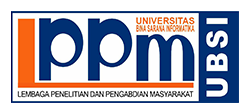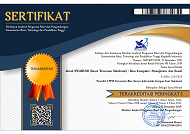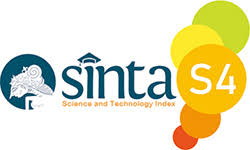Transfer Learning Model dalam Klasifikasi Penyakit Daun Pepaya dengan Pendekatan Arsitektur ResNet152v2
Abstract
Penelitian ini membahas penggunaan model transfer learning ResNet152v2 Untuk klasifikasi penyakit daun pepaya, Metode tradisional dalam mengidentifikasi penyakit tanaman seringkali bersifat subjektif dan bergantung pada pengalaman manusia, yang dapat menyebabkan inkonsistensi dan ketidakakuratan. Dengan memanfaatkan pembelajaran mendalam (Deep learning). Penelitian ini bertujuan untuk mengembangkan model klasifikasi yang efisien dan andal. Dataset yang digunakan terdiri dari tiga kelas : healthy (Sehat), Ringspot (Virus), dan Curl (Keriting pada daun pepaya). Citra pada dataset ini telah melalui tahap preprocessing dan augmentasi guna meningkatkan keragaman data. Model dilatih menggunakan pendekatan transfer learning dengan arsitektur ResNet152v2, dan hasil pelatihan dianalisis berdasarkan metrik akurasi, loss, serta Confusion matrix. Hasil menunjukkan model mampu menunjukkan bahwa model mencapai akurasi pelatihan sebesar 96% dan akurasi validasi sebesar 75% setelah 20 epoch, Untuk kategori Curl, model mencatatkan presisi sebesar 89% dan recall 97%, sedangkan kategori Rinspot menunjukkan presisi 80% dan recall 100%. Namun, recall kategori healthy relatif lebih rendah, yaitu 63%, akibat kesalahan klasifikasi. Akurasi keseluruhan pada pengujian adalah 87%. Penelitian ini menunjukkan potensi Transfer learning dalam klasifikasi penyakit tanaman, meskipun ada tantangan pada keterbatasan dan dan kesalahan klasifikasi.Rekomendasi untuk penelitian selanjutnya mencakup peningkatan variasi dataset, pengoptimalan hyperparameter, serta eksplorasi arsitektur deep learning lain untuk memperbaiki performa klasifikasi, selain itu pengembangan aplikasi berbasis web atau seluler dapat meningkatkan penerapan model ini dalam praktik pertanian.
This study discusses the use of the ResNet152v2 transfer learning model for papaya leaf disease classification, traditional methods of identifying plant diseases are often subjective and rely on human experience, which can lead to inconsistencies and inaccuracies. This study aims to develop an efficient and reliable classification model. The dataset used consists of three classes: healthy, Ringspot (Virus), and Curl (Curly on papaya leaves). The images in this dataset have gone through preprocessing and augmentation stages to increase data diversity. The model was trained using a transfer learning approach with the ResNet152v2 architecture, and the training results were analyzed based on accuracy, loss, and Confusion matrix metrics. The results show that the model is able to demonstrate that the model achieves a training accuracy of 96% and a validation accuracy of 75% after 20 epochs. For the Curl category, the model recorded a precision of 89% and a recall of 97%, while the Rinspot category showed a precision of 80% and a recall of 100%. However, the recall of the healthy category is relatively lower, which is 63%, due to misclassification. The overall accuracy of the test was 87%. This study shows the potential of Transfer Learning in plant disease classification, despite challenges in terms of limitations and classification errors. Recommendations for further research include increasing the variety of datasets, optimizing hyperparameters, and exploring other deep learning architectures to improve classification performance, in addition to developing web or mobile-based applications to improve the application of this model in agricultural practices.
Full Text:
PDF (Bahasa Indonesia)References
Zahrotul Ilmi Wijayanti. (2024). Penerapan Teknologi CNN Dalam Proses Pendeteksi Kematangan Buah Stroberi. Uranus : Jurnal Ilmiah Teknik Elektro, Sains Dan Informatika, 2(3), 01–12.
Suparman, S., Gunawan, B., Apriliani, B., Sirait, D. D. C. P., Lestari, P., Anggreini, P., Rosalinda, A., ... & Zana, B. L. (2023). Tingkat Serangan Organisme Pengganggu Tanaman Berdasarkan Luas Lahan Petani Di Sumatera Selatan. In Prosiding Seminar Nasional Pertanian Pesisir (Vol. 2, No. 1, Pp. 548-550).
Razavi, M., Mavaddati, S., Kobti, Z., & Koohi, H. (2024). Rice-ResNet: Rice classification and quality detection by transferred ResNet deep model. Software Impacts, 20, 100654.
Mayr, P., & Walter, A. K. (2007). An exploratory study of Google Scholar. Online information review, 31(6), 814-830.
Rozaqi, A. J., Arief, M. R., & Sunyoto, A. (2021). Implementation of transfer learning in the convolutional neural network algorithm for identification of potato leaf disease. Procedia of Engineering and Life Science, 1(1).
Faturrahman, R., Hariyani, Y. S., & Hadiyoso, S. (2023). Klasifikasi Jajanan Tradisional Indonesia Berbasis Deep Learning Dan Metode Transfer Learning. Elkomika: Jurnal Teknik Energi Elektrik, Teknik Telekomunikasi, & Teknik Elektronika, 11(4), 945.
Widyaya, J. E., & Budi, S. (2021). Pengaruh Preprocessing Terhadap Klasifikasi Diabetic Retinopathy dengan Pendekatan Transfer Learning Convolutional Neural Network. Jurnal Teknik Informatika Dan Sistem Informasi, 7(1).
Pratama, F., Nasir, M., & Sauda, S. (2020). Implementasi Metode Klasifikasi Dengan Algoritma Support Vector Machine Untuk Menentukan Stok Persediaan Barang Pada Koperasi Karyawan Pangan Utama. Journal of Software Engineering Ampera, 1(2), 71-81.
Setiawan, D., & Suryawijaya, T. (2023). Algoritma Resnet152v2 Dalam Melakukan Klasifikasi Penyakit Pada Daun Tanaman Tomat. Journal Of Computer Science And Technology (Jcs-Tech), 3(2), 37-42.
Auliasari, K. (2021). Feature Extraction And K-Means Clustering Approach To Classify The Covid-19 Lung Ct-Scan Image. Ijiscs (International Journal Of Information System And Computer Science), 5(3), 171-183.
Sutrawati, M., Parwito, P., Zarkani, A., Sariasih, Y., &
Ganefianti, D. W. (2021). First report of Begomovirus infection on papaya in Bengkulu, Indonesia. Jurnal Hama Dan Penyakit Tumbuhan Tropika, 21(1), 49-55.
Wiyono, S. (2012). Penyakit Keriting Daun Pepaya yang Disebabkan oleh Cladosporium cladosporioides. Jurnal Fitopatologi Indonesia, 8(1), 28-28.
Indriyani, N. L. P., & Affandi, S. D. (2008). Pengelolaan Kebun Pepaya Sehat. Solok (ID): Balai Penelitian Tanaman Buah Tropika.
DOI: https://doi.org/10.31294/swabumi.v13i1.25278
INDEXING

P-ISSN : 2355-990X E-ISSN: 2549-5178













